
Qatar MotoGP: Márquez on another level, Viñales out of luck
Marc Márquez was on another level at Losail, while Viñales magicked amazing speed out of nowhere in the 2025 MotoGP Qatar GP, Honda made another step and Martin put himself back in hospital
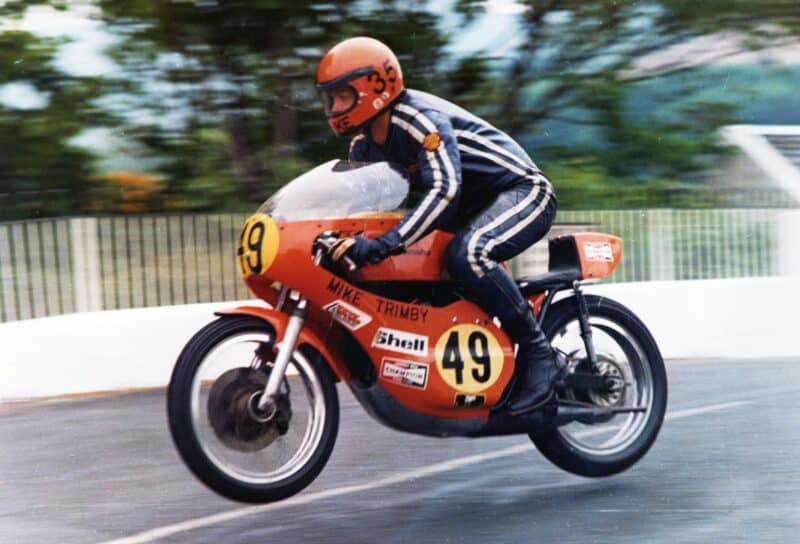
Trimby racing on the Isle of Man in 1974
Trimby archive
This interview is from 2020 – we publish it here in respect for Mike Trimby, who has died aged 74
Former racer Mike Trimby has worked in the MotoGP paddock since the early 1980s and is largely responsible for the four cornerstones of the spectacle that we all know and love: improving circuit safety, putting the races on TV, organising the teams and making sure everyone gets paid.
Trimby started out as a revolutionary – going after the cigar-chomping, blazer-wearing racing establishment who treated the riders like performing animals. The first battles he fought was for better safety, better paddock conditions and better money.
“The old promoters and the FIM treated us like shit,” recalls ‘King’ Kenny Roberts, a 500cc GP winner from 1978 to 1983. “It was just wrong, they had us by the balls. Some of the tracks were so dangerous it was stupid. And you’d have to tickle the promoters’ balls to get500 bucks more. The whole thing was like a mafia deal.”
In 1982 Roberts, Barry Sheene, Franco Uncini and other top riders hired Trimby to fight for their rights, because they were too busy racing to waste time arguing with the old-boys network of the FIM (the Fédération Internationale de Motocyclisme, the sport’s governing body) and the promoters.
The priorities of the old crooks running the show was to keep prize money low and spend nothing on the circuits. If riders died, so be it. “The throttle works both ways,” was their mantra. In other words, if you die it’s your fault, not ours.
The death toll was horrific. During the 1950s, 29 riders died at grands prix, roughly one death every other event. The 1960s claimed 25 lives, the 1970s took 24. No wonder the riders had had enough.
“At the 1982 French GP the riders went on strike, because of track safety and paddock facilities,” says Trimby, 71. “Someone told them they needed to be represented properly, so I got summoned. Some of the riders knew me from when I was racing, so they said, ‘We haven’t got any better ideas, so let’s go with Mike.”
Trimby has been a motorcycle fanatic since he was a kid, when his dad took him on the pillion of his 197cc James to watch scrambles, trials and roadraces. He started racing Aermacchi singles in the late 1960s, moved up to Yamaha TD and TZ twins and then a TZ750 and endurance racing, from the Macau GP to the Bol d’Or and Suzuka Eight Hours.
“The top riders agreed to pay me 3% of their prize money, which wasn’t much, but that wasn’t a huge problem because I was making my money by running a road-racing show in London and helping with the Macau GP. I started at the Yugoslavian GP in July 1982. Uncini was the riders’ representative, so he told the FIM: ‘Don’t talk to us anymore, speak to Mr Trimby’. The president of the FIM jury said, ‘No way!’, and threw me out of the meeting.
“That wasn’t an auspicious start but I just kept bashing away. I embarked on various campaigns – the main thing was safety, because safety was horrendous.”
During August 1982 GP racing suffered a very dark day at Silverstone, when Norman Brown and Peter Huber lost their lives in the 500cc race. The man supposed to be in charge was Vernon Cooper, chairman of the ACU, British bike racing’s governing body.
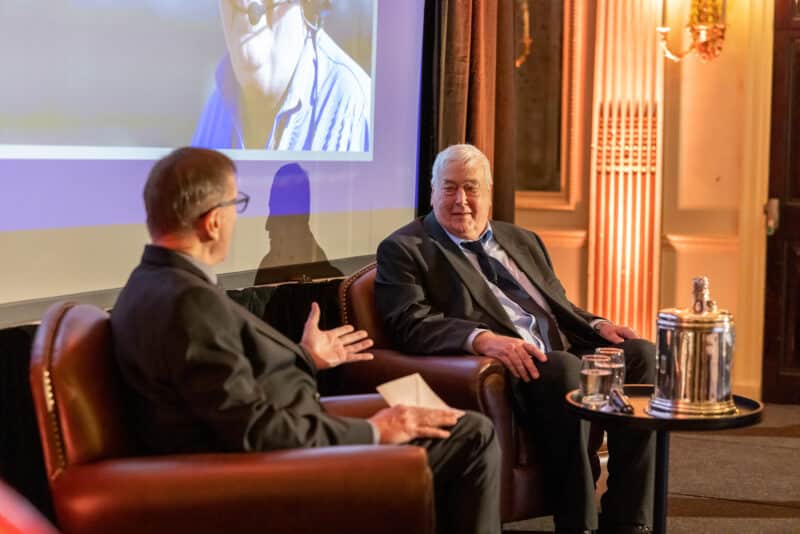
Trimby receiving the Torrens Trophy at the Royal Automobile Club earlier this year, being interviewed by Keith Huewen
Royal Automobile Club
“Cooper was totally incompetent and a nasty piece of work,” Trimby adds. “I was stood with him that afternoon because I knew he’d screw up anyway, not because I’d anticipated the awful accident. He didn’t know what the hell was going on, because he had no communication with the marshals, so when Roberts came past the start/finish waving his fist, that was the first time Cooper knew that something was wrong. It was a nightmare.”
Trimby and Roberts set BBC investigative journalist Roger Cook onto Cooper. The highlight of Cook’s Checkpoint documentary Uneasy Rider had him door-stepping Cooper at his home, where his Jaguar – with personalised reg plate – stood on the gravel drive. Mrs Cooper assured Cook that her husband was out and called the police. Minutes later Cooper escaped in his Jag, scattering gravel in all directions.
Eight months after the Silverstone tragedy two more riders perished, at the 1983 French GP. During practice Iwao Ishokawa was hit by another rider, whose brakes had failed. There was no medical helicopter, so Ishokawa was transported by ambulance, which got lost. By the time the Japanese arrived at hospital, several hours after the accident, he was dead.
Three days later Swiss star Michel Frutschi died during the 500 race, when he crashed and hit a wooden pole, dug into the ground to hold up lines of catch-fencing, put there to improve safety. At the time his girlfriend was pregnant with their first child.
“After that, catch-fencing poles were our main campaign. We’d arrive at a track, ask the organisers to rip out the catch-fencing and replace it with rows of haybales. The idea was that when a rider crashed he’d gradually demolish the haybales, which slowed him down without killing him.
“When we went to Mugello we told them we wanted the catch fences taken out and replaced by haybales. The promoter took me to the start line, where there was a big truck piled up with ‘bales. He said, ‘There you are, go and put them out!’. So we did – us and the riders.
“Getting rid of catch-fencing definitely saved lives. After that it was just bashing away until we got some movement on general circuit safety.”
Inevitably Trimby’s successes made him a marked man among the racing establishment, who were terrified of any change to the status quo.
But he had the riders on his side and they were increasingly militant, determined to overthrow the system which had been robbing them and killing them for decades.
“People like Roberts were brilliant. One year I went to Jarama and they wouldn’t let me in, because they knew what I was up to, so Kenny said, ‘If Trimby doesn’t come in, we don’t come in’. He was always there, supporting me up front, arguing. Kenny, Randy Mamola, Christian Sarron and Freddie Spencer were the same – together we made a difference.”
Hay bales saved lives but couldn’t make every track safe; for example, Belgium’s epic Spa-Francorchamps. This was Trimby’s next focus: to fix the most dangerous circuits. Over the decades Spa had claimed many lives and in July 1984 it killed British 500 privateer Kevin Wrettom, who crashed at the lethal 150mph Blanchimont corner.
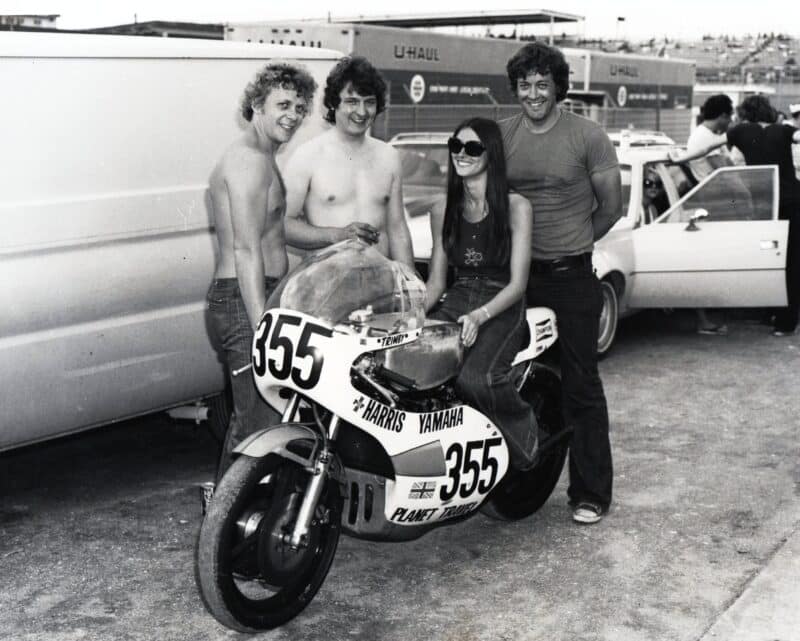
Trimby (right), with wife Irene and Steve Bayford (left) and Steve Harris from Harris chassis
Trimby archive
“At that time the FIM had its first road-racing chief who was somewhat sympathetic to the riders’ cause. Luigi Brenni wrote out a homologation requirement for Spa after Wrettom’s death, requiring the barriers at Blanchimont to be moved back so many metres before we went to race there in 1987.
“At Assen in 1987, the weekend before Spa, we heard rumours that they hadn’t moved the barriers, so Randy and I got in a car and drove to Spa. There was lots of work going on – putting up grandstands and so on – but nothing had been done to that corner, so we took photos, drove back to Assen and showed them to Brenni, who convened a meeting and cancelled the Spa GP. That sent shockwaves through the business, because at last we had some clout, which made other organisers sit up and take notice.”
The FIM reacted quickly. They dismissed Brenni and installed Joe Zegwaard, who knew which side his bread was buttered.
“Zegwaard was an obnoxious prick. Not long after Brenni cancelled the race at Spa I went to another FIM meeting, where Zegwaard threw me out. These people would sit around and discuss everything, from the tracks to the calendar, with no consideration whatsoever for the people taking part.
“Despite everything I enjoyed it tremendously. It wasn’t just safety, we were also banging on about money. At that time the main motive was to get better for money for the people at the back of the grid, because the top guys were already well paid, but the ones who were filling the grid were getting peanuts. So we put in this demand to double their money. We didn’t get it but we got an extra 30%, which was a big help.”
Then Trimby started working on the paddock, because conditions at some circuits were medieval, with repulsive toilets and inadequate running water and electricity.
“The toilets at Nogaro were so bad that we used to jump on our paddock bikes every morning and ride into town to get a coffee and use the toilet.
“Back then the biggest race didn’t happen on Sunday afternoon, it happened between one grand prix and the next, because if you didn’t get a decent place in the paddock you’d have no water and no electricity. You’d have to do things like run cables through the windows of the toilets and adapt the light fitting to get some sort of a power supply.
“We also started organising the paddock because I realised the place was an unexploded bomb. At Imola one year I was in the paddock in my motorhome, with my gas water boiler, with its naked flame, going ten to the dozen, right next to Suzuki’s tent, where they were washing down bikes with petrol. I thought this is a bomb waiting to go off. After that we moved all the motorhomes away from the working area into a living area.”
In 1986 Trimby and several other paddock movers and shakers formed IRTA (the International Roadracing Team Association), to oversee GP racing’s next steps into the modern world.
“I’d come to the realisation that there wasn’t much more I could do as an individual on safety and money. The only way we could do it was by getting the teams together.

Trimby and TV investigator Roger Cook during the making of the BBC’s Checkpoint documentary Uneasy Rider
“One of our main objectives was sorting out TV coverage, because television was crucial to the development of the sport. At that time each individual race organiser owned its own TV rights, which many didn’t sell. So it was impossible for any broadcaster to put the whole series on TV. So we persuaded the FIM to take the TV rights back from the organisers and centralise them.
“We hired [Formula 1 mogul] Bernie Ecclestone to take over the TV rights, because if we hadn’t used him he would’ve scuppered us. The money Bernie paid us was split between the FIM, IRTA and the organisers. We spent IRTA’s share on on-bike cameras, so the first on-bike cameras were paid for by us, to improve the TV show.”
Ecclestone’s ultimate aim was to fully take over bike GPs and turn them into a two-wheeled F1. He established a new company – Two Wheel Promotions – and went to work.
“This was the big battle…” says Trimby.
At the start of the 1992 season there were four different bodies involved in bike grands prix. The FIM still owned the championship, but had sold the commercial rights to TWP, which delegated organisational and financial duties to IRTA, while a new company – Dorna – arrived on the scene to buy the TV rights.
“One of the reasons Bernie got his deal done was that he persuaded his big mate Max Mosley [FIA president] to change the statutes of the FIA, so they could sanction any form of motorsport, not just four wheels. That rattled the cages of the FIM and helped secure the deal. That was the sort of power Bernie had.
“Then Bernie played everyone off against everyone, as was his skill. Within 12 months he had hypnotised Dorna into buying out Bernie’s interest for $50 million. Bernie cashed in big time and Dorna almost went out of business.
“He also stitched us up on a few things, but by the end of 1993 he was gone. Thank God he sold to Dorna, because they’ve been brilliant partners.”
IRTA is now responsible for numerous areas of MotoGP: as well as working with Dorna to contract the teams they also organise the paddock and the grid and look after facilities for out-of-Europe races, as well as supplying race director Mike Webb, FIM chief steward Freddie Spencer and technical director Danny Aldridge to the series.
During the past three decades Dorna – now led by Carmelo Ezpeleta – have made huge changes to MotoGP, most importantly switching from two-strokes to four-strokes.
In recent years Dorna has worked to minimise the performance gap between the front and back of the grids. This has been achieved by rewriting the technical regulations in all classes: MotoGP, Moto2 and Moto3. The two smaller categories go furthest, with sealed engines distributed randomly to riders, so that no one has a significant horsepower advantage.
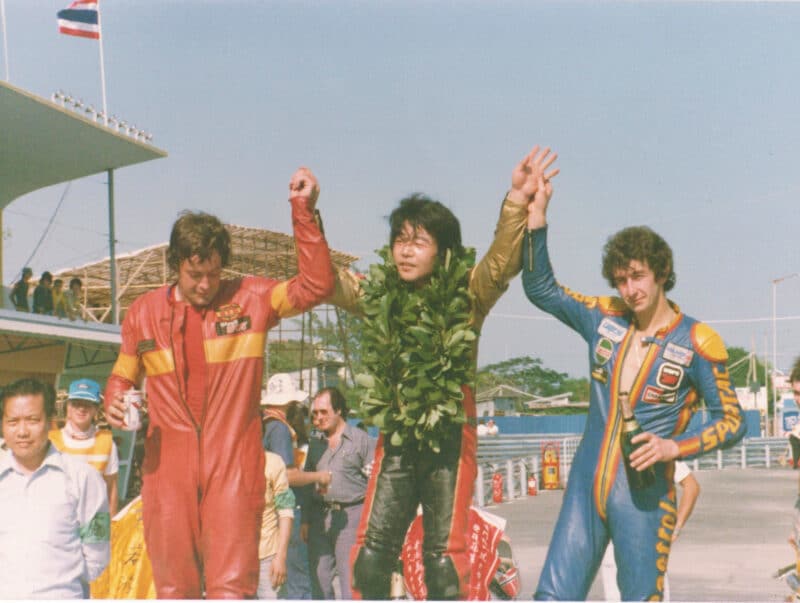
Trimby (left) after finishing third to Sadao Asami and Steve Parrish in the 1978 Macau Grand Prix
Trimby archive
“We’ve made it possible for everyone to be competitive, not only by having equal engines, but by taking away the situation where Aprilia were basically selling championships. In the days of 250s a bike cost around 100,000 Euros, but if you wanted to win races you had pay a million Euros for the best Aprilia. And if you wanted the latest exhaust it was another 100,000, so a rich team could buy the championship. That can’t happen anymore – now it’s down to the organisation of the team and the quality of the rider.
“I also supported Dorna in levelling the playing field in MotoGP, particularly by reducing the level of electronics, because it’s no good having Honda, Yamaha and Ducati running around at the front if the rest of the pack is nowhere. I think that Carmelo’s single biggest achievement in sorting out MotoGP was getting the single ECU approved.”
MotoGP isn’t perfect and never will be, but from technical, commercial and safety points of view, it’s never been in a better place.

Marc Márquez was on another level at Losail, while Viñales magicked amazing speed out of nowhere in the 2025 MotoGP Qatar GP, Honda made another step and Martin put himself back in hospital

Bagnaia won his first race of 2025 at COTA but he’s still 5-1 down to his team-mate Marc Márquez, so how will their duel go this weekend in Qatar, which is supposed to better suit Bagnaia’s riding style?

Motorcycle racing is a nasty business, which is why many greatest racers indulge in questionable tactics. Following Marc Márquez’s COTA stunt, here are a few dodgy tales about former MotoGP kings Barry Sheene, Eddie Lawson and Phil Read
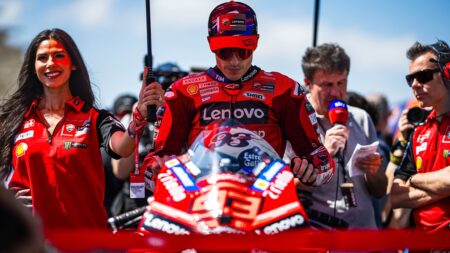
Marc Márquez seemed to have hoodwinked them all before Sunday’s COTA Grand Prix got underway, then he threw it all away and Pecco Bagnaia swept to his first win of 2025